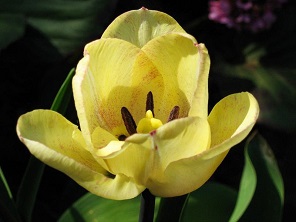Flower bulbs, a wonderful product. Again and again, tourists gasp at the sight of purple, yellow and red fields in Holland’s flower bulb area. Dutch cut flowers and flower bulbs are in great demand. But could not entrepreneurs create value from the multitude of high-quality substances contained in them? And reduce their waste problem at the same time?

This week, bulb producers scanned these questions at the Innovation and Demonstration Centre (IDC) Bulbs and Perennials in Lisse. Such IDC’s are created as centres where entrepreneurs can get help on knowledge and innovation. Sustainability and profitability are the main focus points.
Pigments from petals
Flower bulbs and other unused plant parts (sometimes petals) contain high-quality substances in small amounts. The example of galantamine is well-known, an anti-Alzheimer drug that can be produced from daffodils. But in many instances, the business case is quite uncertain. Maybe after all, galantamine is more cheaply produced synthetically than from flower bulbs? Would not be registration of the medicine be so costly that it is beyond the reach of a small player?
Many examples were mentioned in the meeting ‘Biobased opportunities for bulb and perennials producers’. One of the speakers had calculated that the 170 tons of petals (dry weight) discarded annually in the flower bulb area, contain 50 kg of anthocyanins. Anthocyanins are vegetal pigments, colouring red cabbage and autumn leaves among others. Some of these pigments sell at high prices, up to € 40,000 per gram. Could not this add up to a sound business case for the growers of flower bulbs? Another example might be the recovery of fragrances from lily buds, more precisely: the precursors to fragrances. In growing these flower bulbs, lily buds are cut before flowering; they then do not yet contain these substances themselves, but their precursors. Therefore, with one or two chemical reactions these fragrances could be produced from the lily. Theoretically very interesting as well.

A ‘library’ of the contents of flower bulbs
Researchers have investigated the composition of many flower bulbs and drawn up a complete inventory of components, technically known as the ‘library’. But the library does not list which industries are interested in these compounds. Chemical scientists would have to study it in order to suggest profitable projects. At the meeting, participants came up with a number of examples. Like that of the Dutch horticulturalist who will grow foxglove (digitalis) for extraction of digoxin, a drug against heart failure. Recovery of latex (for rubber production) from the Russian dandelion. And growing plantain for production of aucubine among others, a strong antibacterial substance. And researchers might have to go to the countries of origin of our flower bulbs, like Turkey, in order to note from lore the medical applications of the original species. As a guideline for further research: identification of the active substance, tests, market research. After having identified a sound business case, there will still be a selective breeding step, in order to maximise the yield.
The market
The question that looms is always: will there be a market demand for the substances from our flower bulbs? Of course, there were very few participants from the cosmetics business and none from the pharmaceutical industry. Although there seem to be talks. In view of the tough testing procedures for pharmaceuticals, cosmetics might be a more attractive target. The decisive factor for discovering common ground would seem to be developing a basis of mutual trust. That would mean investment in the future, for trust must be gained. Maybe these talks would require to have the ‘library’ at hand, in order to discover any common fields of interest.
If growers cannot find markets for chemical specialties present in their flower bulbs, they can still revert to the bulk market: finding useful applications for fibres, sugars and proteins. For fodder production, as a start. Or, if that would not work, to be ploughed in the land. Or for processing to biogas at the regional waste processing unit. Although that would be much less profitable.
